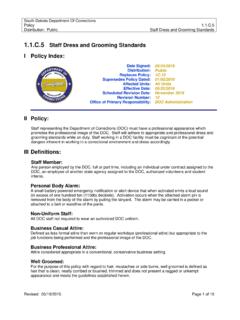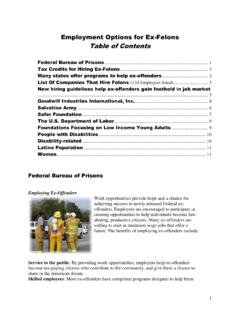Transcription of LSI-R Assessment and Case Planning
1 South Dakota Department Of Corrections Policy Distribution: Public Assessment and Case Planning Revised: 11/03/2015 Page 1 of 17 LSI-R Assessment and Case Planning I Policy Index: Date Signed:11/06/2015 Distribution:Public Replaces Policy:N/A Supersedes Policy Dated:10/01/2013 Affected Units:Adult Institutions Effective Date:11/09/2015 Scheduled Revision Date:August 2016 Revision Number:8 Office of Primary Responsibility:DOC Administration II Policy: The Department of Corrections (DOC) will use the LSI-R Assessment to help determine an inmate s programming needs and to prioritize programming based on the inmate s overall need. III Definitions: LSI-R : Level of Service Inventory-Revised. An Assessment used to measure an inmate s risk to reoffend and to define the inmate s programming needs.
2 LSI Core: Programs required and/or recommended as a result of the LSI-R Assessment ; Thinking for a Change (T4C), Moral Recognition Therapy (MRT). Custody Classification Risk: The risk levels of Maximum, High Medium, Low Medium and Minimum are used to predict an inmate s risk of institutional escape and violence (See DOC policies Male Inmate Classification and Female Inmate Classification). Community Risk: A level of risk established by the Community Risk Assessment which is used to predict the risk of an individual parolee s supervision failure (See DOC policy Parole Services-Community Risk Assessment and Supervision of Offenders). P-Scan: An Assessment used to rate the inmate's tendency toward psychopathic behaviors. New Admission: A person sentenced to serve time with the DOC who is admitted to a DOC facility for the first time under that sentence; including new commitments, suspended imposition of sentence (SIS) and suspended execution of sentence (SES) admissions, Federal Bureau of Prison admissions, and Federal Probation and Parole admissions.
3 This definition specifically excludes parole/suspended sentence violators, Marshal Holds, detainees and extended detainees . South Dakota Department Of Corrections Policy Distribution: Public Assessment and Case Planning Revised: 11/03/2015 Page 2 of 17 Parole/Suspended Sentence Violator (PV/SSV): An offender under supervision who is transferred from the supervision of a parole agent to a DOC facility following a violation of the offender s supervision agreement. Detainee: An offender whose supervision is transferred by a parole agent to a DOC facility for a period not to exceed five (5) working days (120 hours), excluding weekends and holidays. Within the five (5) working days (120 hours) detainment period, the parolee must either be released, be designated as a parole violator or self-commit to the Community Transition Program (CTP).
4 The detainment can be extended an additional five (5) working days (120 hours) by authorization of a parole supervisor. The Executive Director of the Board of Pardons and Paroles must authorize a detention beyond the additional five (5) working days (120 hours) detention. Extended Detainee: An extension to a detainer, authorized by the Executive Director of Parole Services, which is issued for a variety of reasons, such as investigative purposes, waiting for a placement opening, a disciplinary sanction to a violation of the supervision agreement, etc. (See ARSD 17:61:01:01 (4) and 17:61:01:11). The detainment extension may be for up to ninety (90) calendar days. Marshal Hold: An inmate placed in a DOC facility under contract by the Marshals until arrangements are made to transfer the inmate to federal custody.
5 Motivational Interviewing: A direct counseling style for eliciting behavior change by helping inmates to explore and develop ambivalence toward their criminal behavior, which in turn motivates the inmate to address and resolve factors contributing to criminal behavior. Scheduled Programs: Academic (GED, Basic Ed and Literacy), Chemical Dependency Treatment, Sex Offender Treatment, Vocational Education, Thinking for a Change and Moral Recognition Therapy. IV Procedures: 1. LSI-R Assessment A. The main objective of the LSI-R Assessment is to reduce recidivism by identifying and targeting an inmate s specific criminogenic needs through programming and the use of motivational interviewing. B. Admission case managers will complete LSI-R assessments on all new admissions, parole violators, and suspended sentence violators admitted from the community.
6 (A new LSI-R is not completed on suspended sentence violators who have their suspended sentence imposed prior to release to the community. C. If unit staff believes an inmate s LSI-R Assessment is inaccurate, staff will consult with the Risk Reduction Manager to determine if another LSI-R Assessment should be administered. D. LSI-R assessments will be conducted in conjunction with trailer assessments administered by Behavioral Health staff and Education staff. South Dakota Department Of Corrections Policy Distribution: Public Assessment and Case Planning Revised: 11/03/2015 Page 3 of 17 E. Admissions Case managers will interview each inmate using the LSI-R interview guide and motivational interviewing. F. Case managers will make referrals for additional Assessment work to Behavioral Health and/or Education staff based on the results of the LSI-R and trailer assessments.)
7 G. In addition to sources identified within this policy, case managers may use other available sources to confirm information scored on the Assessment . 2. LSI-R Interview Scoring Guide: A. LSI-R Assessment subgroup 1 CRIMINAL HISTORY: 1. The case manager will develop a criminal history profile based on current and past offenses. Sources: Criminal History sheet in the legal file. a. Past offenses include all felony and misdemeanor convictions received as an adult or juvenile. 1) A search of the Comprehensive Offender Management System (COMS) will be completed for all inmates to verify the existence of any juvenile history. b. Juvenile history starts with the earliest arrest or adjudication of the juvenile. c. The items referencing previous adult convictions and number of prior adult convictions are cumulative; the same inmate can be scored on items , and (below).
8 2. The following items will be scored after the interview. The case manager will gather the following information: a. Any previous adult convictions (Score if yes ). b. Number of prior adult convictions > 2 (Score if two or more). c. Number of prior adult convictions > 3 (Score if three or more). d. Number of current offenses/transactions on this admission > 3 (Score if three or more). e. Juvenile arrest under the age of sixteen (Score if yes ). f. Incarcerated upon conviction (This item will always be scored yes ). g. Any escape or attempted escape history from a court ordered facility/placement. (Score if yes .) DO NOT SCORE ABSCONDING FROM PAROLE/PROBATION OR FLEEING FROM ARREST/ELUDING POLICE. h. Disciplinary record while in prison (Score if the inmate was ever found to have committed a major Offense in Custody and a sanction was imposed).
9 I. Probation or parole violations where a sanction was imposed by the supervising agent. A revocation is not necessary to score this information. Sources: COMS, parole violation reports, probation violation reports, technical violations and inmate self-report (Score if violations are present) (See DOC policy Response to Violations). South Dakota Department Of Corrections Policy Distribution: Public Assessment and Case Planning Revised: 11/03/2015 Page 4 of 17 j. Incidence of violence This item includes any act of violence. A felony conviction is not required. Sources: COMS, public school records, DOC juvenile system information, institutional disciplinary, inmate self-report, NCIC, criminal history database, PSI, parole and jail reports (Score if violence is present). k.
10 Information about any victim(s) will be gathered; age, gender, relationship to the inmate. B. LSI-R Assessment subgroup 2 EDUCATION AND EMPLOYMENT HISTORY. 1. The case manager will develop an educational and employment profile based on the inmate s work history and educational involvement. 2. The following will be scored for the employment profile: a. Current employment status Is the inmate unemployed? If the inmate is serving a short sentence 60 days or less and states he/she will still be employed upon release- attempt to verify this information. Do not score if it can be verified the inmate is serving a short sentence and will still be employed when he/she gets out of prison. If the inmate has been incarcerated for more than two (2) years, employment history while incarcerated is scored.







